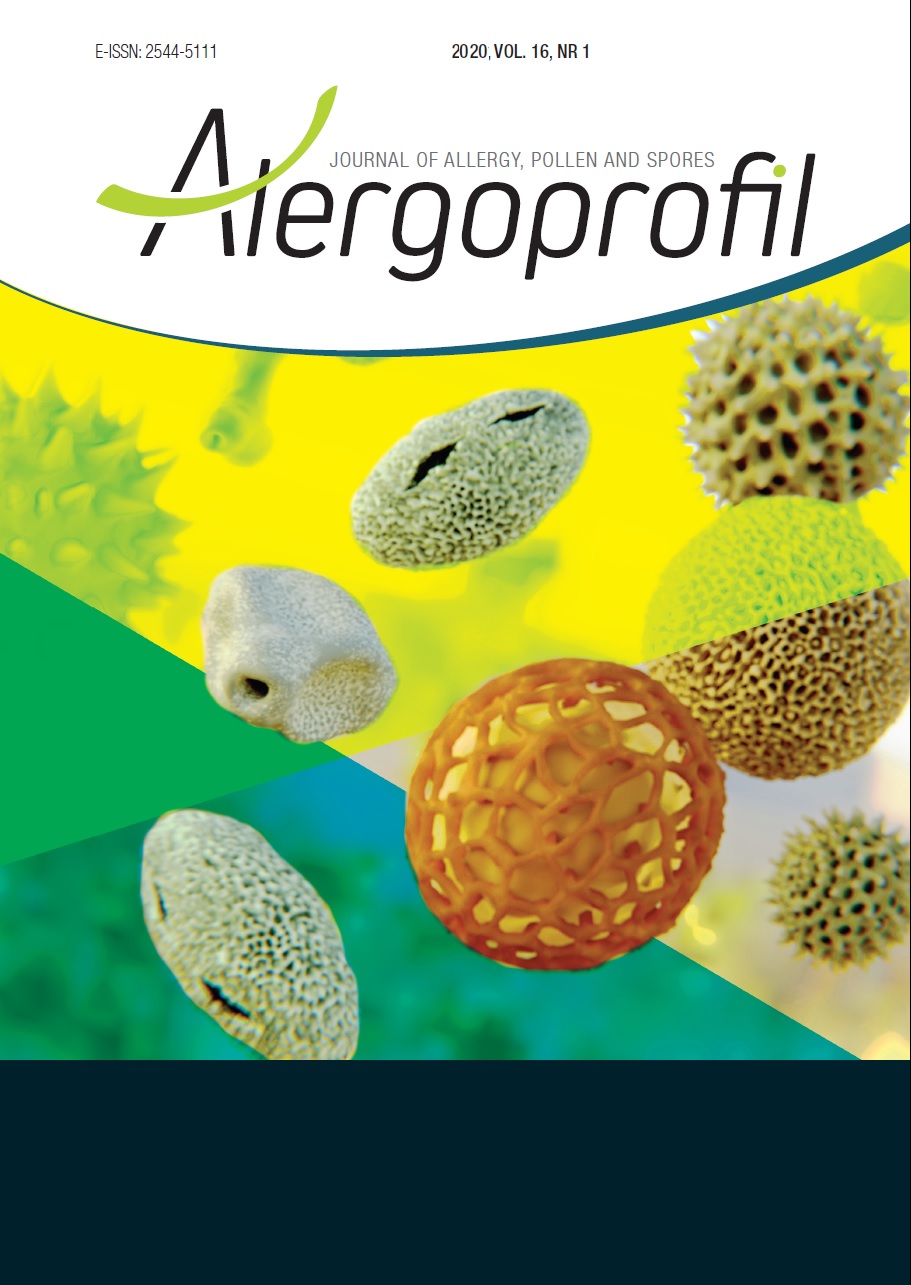Analysis of Corylus pollen season in Poland in 2020 Original article
Main Article Content
Abstract
In Poland hazel is one of the earliest flowering plants and in phenology it belongs to indicator plants that mark the beginning of early spring. Hazel pollen grains contain allergens that are a cause of pollen allergy during the early spring period. The aim of the present study was to compare Corylus pollen seasons in 2020 in the following 11 cities located in different regions of Poland: Szczecin, Bydgoszcz, Zielona Gora, Wroclaw, Opole, Sosnowiec, Piotrkow Trybunalski, Warsaw, Lublin, Olsztyn, and Bialystok. This research was conducted using the volumetric method and Burkard or Lanzoni pollen samplers. Pollen season duration was determined by the 95% method. This study analyzed the specific parameters of the pollen season (start, end, peak value, peak date, annual total) and also determined the number of days with a concentration exceeding the threshold values at which the first allergy symptoms in people sensitized to hazel pollen and symptoms in all allergic patients occur, respectively. The hazel pollen season in 2020 began relatively early, between January 11th and February 2nd. The season start was recorded earliest in Opole and latest in Olsztyn and Bialystok. The study found that the pollen season started earlier in the western part of Poland than in the eastern regions. The highest maximum Corylus pollen concentration was recorded in Lublin (388 P/m3), whereas the lowest one in Bydgoszcz (48 P/m3). The maximum daily concentration of Corylus pollen grains was recorded in different periods in the individual cities, while the peak concentration values occurred between January 31th and March 4th. The highest risk of allergy in people sensitive to the pollen of this taxon was found in Lublin since the most days with a pollen concentration exceeding the threshold value were observed in this city. Lublin was found to have the highest annual total values and they were 1.6–5.6 times higher than in the other cities. The highest annual pollen sums and peak values as well as the highest number of days with a concentration exceeding the threshold value had also been recorded in Lublin previously.
Downloads
Article Details
Copyright: © Medical Education sp. z o.o. This is an Open Access article distributed under the terms of the Attribution-NonCommercial 4.0 International (CC BY-NC 4.0). License (https://creativecommons.org/licenses/by-nc/4.0/), allowing third parties to copy and redistribute the material in any medium or format and to remix, transform, and build upon the material, provided the original work is properly cited and states its license.
Address reprint requests to: Medical Education, Marcin Kuźma (marcin.kuzma@mededu.pl)
References
2. Frei T, Torricelli R, Peeters AG et al. The relationship between airborne pollen distribution and the frequency of specific pollen sensitization at two climatically different locations in Switzerland. Aerobiologia. 1995; 11: 269-73.
3. Kadocsa E, Juhasz M. Study of airborne composition and allergen spectrum of hay fever patients in South Hungary (1990-1999). Aerobiologia. 2002; 18: 203-9.
4. Erkara IP, Cingi C, Ayranci U et al. Skin trick test reactivity in allergic rhinitis patients to airborne pollens. Environ Monit Assess. 2009; 151: 401-12.
5. Hauser M, Roulias A, Ferreira F et al. Panallergens and their impact on the allergic patient. Allergy Asthma Clin Immun. 2010; 6(1): 1.
6. Piotrowska K. Ecological features of flowers and the amount of pollen released in Corylus avellana (L.) and Alnus glutinosa (L.) Gaertn. Acta Agrobotanica. 2008; 61(1): 33-9.
7. Puc M. The effect of meteorological conditions on hazel and alder pollen concentration in the air of Szczecin. Acta Agrobotanica. 2007; 60(2): 65-70.
8. Sokołowska J. Przewodnik Fenologiczny. Wydawnictwo Komunikacji i Łączności, Warszawa 1980.
9. Myszkowska D, Jenner B, Puc M et al. Spatial variations in dynamics of Alnus and Corylus pollen seasons in Poland. Aerobiologia. 2010; 26: 209-21.
10. Piotrowska-Weryszko K, Weryszko-Chmielewska E. Charakterystyka sezonów pyłkowych leszczyny i olszy w Lublinie w 2014 r. Alergoprofil. 2014; 10(2): 21-3.
11. Rodriguez-Rajo FJ, Dopazo A, Jato V. Environmental factors affecting the start of pollen season and concentrations of airborne Alnus pollen in two localities in Galicia (NW Spain). Ann Agric Environ Med. 2004; 11: 35-44.
12. Ariano R, Canonica GW, Passalacqua G. Possible role of climate changes in variations in pollen seasons and allergic sensitizations during 27 years. Ann Allergy Asthma Immunol. 2010; 104(3): 215-22.
13. Weryszko-Chmielewska E, Piotrowska-Weryszko K, Dąbrowska A. Response of Tilia sp. L. to climate warming in urban conditions – phenological and aerobiological studies. Urban For Urban Gree. 2019; 43: 126369.
14. Skjøth CA, Bilińska D, Werner M et al. Footprint areas of pollen from alder (Alnus) and birch (Betula) in the UK (Worcester) and Poland (Wrocław) during 2005–2014. Acta Agrobotanica. 2015; 68(4): 315-24.
15. Rapiejko P, Lipiec A, Wojdas A et al. Threshold pollen concentration necessary to evoke allergic symptoms. Int Rev Allergol Clin. 2004; 10(3): 91-3.
16. Weryszko-Chmielewska E (ed). Pyłek roślin w aeroplanktonie różnych regionów Polski. Wydawnictwo Akademii Medycznej w Lublinie, Lublin 2006.
17. Piotrowska K, Kaszewski BM. The influence of meteorological conditions on the start of the hazel (Corylus L.) pollen season in Lublin, 2001-2009. Acta Agrobotanica. 2009; 62(2): 59-66.
18. Piotrowska-Weryszko K, Konarska A, Kaszewski BM et al. Analysis of Corylus pollen seasons in selected cities of Poland in 2018. Alergoprofil. 2018; 1(14): 21-6.
19. Piotrowska-Weryszko K, Konarska A, Puc M et al. Corylus pollen season in Poland in 2019. Alergoprofil. 2019; 15(1): 16-21.

